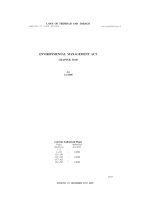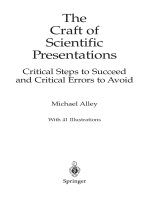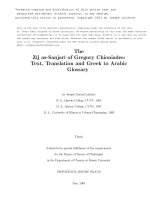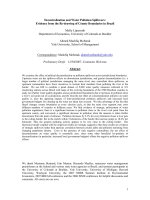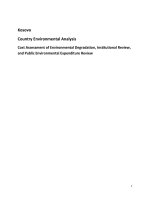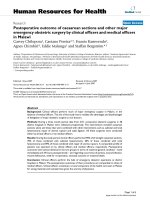Drawing of rods, wires and tubes Subjects of interest docx
Bạn đang xem bản rút gọn của tài liệu. Xem và tải ngay bản đầy đủ của tài liệu tại đây (1.02 MB, 47 trang )
Suranaree University of Technology Jan-Mar 2007
Drawing of rods, wires
Drawing of rods, wires
and tubes
and tubes
• Introduction/objectives
• Rod and wiredrawing
• Analysis of wiredrawing
• Tube drawing processes
• Analysis of tube drawing
• Residual stress in rod, wire and tubes
Chapter 5
Subjects of interest
Tapany Udomphol
Suranaree University of Technology Jan-Mar 2007
Objectives
Objectives
• This chapter provides fundamental background on
processes of drawing of rods, wires and tubes.
• Mathematical approaches for the calculation of drawing
load will be introduced.
• Finally drawing defects occurring during the process will be
highlighted and its solutions will be included.
Tapany Udomphol
Suranaree University of Technology Jan-Mar 2007
Introduction :
wire drawing
• Wire drawing involves reducing the
diameter of a rod or wire by passing
through a series of drawing dies or
plates.
• The subsequent drawing die must have
smaller bore diameter than the
previous drawing die.
www.e6.com
Undrawn
wire
Drawn
wire
Drawing die
Tapany Udomphol
Suranaree University of Technology Jan-Mar 2007
Introduction :
Tube drawing
• Tube drawing involves reducing
the cross section and wall
thickness through a draw die.
Brass tubes for heat exchanger –
cheap, strong, good corrosion
resistant
• The cross section can be circular,
square hexagonal or in any shapes.
Tapany Udomphol
Suranaree University of Technology Jan-Mar 2007
• Drawing operations involve pulling metal through a die by means of
a tensile force applied to the exit side of the die.
• The plastic flow is caused by compression force, arising from the
reaction of the metal with the die.
• Starting materials: hot rolled stock (ferrous) and extruded (non-
ferrous).
• The metal usually has a circular symmetry (but not always,
depending on requirements).
• Bar wire and tube drawing are usually carried out at room
temperature, except for large deformation, which leads to
considerable rise in temperature during drawing.
Introduction
• Material should have high ductility and good tensile strength.
Tapany Udomphol
Suranaree University of Technology Jan-Mar 2007
Rod and wiredrawing
Rod and wiredrawing
• Same principals for drawing bars, rods, and wire but
equipment is different in sizes depending on products.
Rods relatively larger diameter products.
Metal wires
Metal rods
• Reducing the diameter through plastic deformation while the
volume remains the same.
Wires small diameter products < 5 mm diameter.
Tapany Udomphol
Suranaree University of Technology Jan-Mar 2007
• Rods which can not be coiled, are
produced on drawbenches.
Insert though the die
Rod is swaged
Clamped to the jaws of the drawhead
The drawhead is moved by a hydraulic mechanism
Machine capacity :
• 1 MN drawbench
• 30 m of runout
• 150-1500 mm.s
-1
draw speed
Rod drawing
Draw head
Metal
stock
Tapany Udomphol
Wire drawing die
Conical drawing die
• Shape of the bell causes hydrostatic
pressure to increase and promotes the flow
of lubricant into the die.
• The approach angle – where the
actual reduction in diameter occurs,
giving the half die angle α.
α.α.
α.
• The bearing region produces a
frictional drag on the wire and also
remove surface damage due to die wear,
without changing dimensions.
Suranaree University of Technology Jan-Mar 2007
• The back relief allows the metal to expand slightly as the wire leaves the die
and also minimises abrasion if the drawing stops or the die is
out of alignment.
• The die nib made from cemented
carbide or diamond is encased for
protection in a thick steel casing.
Drawing die
Tapany Udomphol
Example of wiredrawing dies
A drawing of wire drawing die
Suranaree University of Technology Jan-Mar 2007
Undrawn
wire
Drawn
wire
Drawing die
Tapany Udomphol
Example of wiredrawing dies
Wire drawing die made from cemented tungsten
carbide with polycrystalline diamond core.
Suranaree University of Technology Jan-Mar 2007
Tapany Udomphol
Suranaree University of Technology Jan-Mar 2007
Drawing die materials
• Most drawing dies are cemented carbide or
industrial diamond (for fine wires).
• Cemented carbides are the
most widely used for drawing
dies due to their superior
strength, toughness, and wear
resistance.
• Polycrystalline Diamond (PCD)
used for wire drawing dies – for
fine wires. Longer die life, high
resistance to wear, cracking or
bearing.
img.tradekey.com
• Cemented carbide is composed of
carbides of Ti, W, Ni, Mo, Ta, Hf.
Tapany Udomphol
Suranaree University of Technology Jan-Mar 2007
Wire drawing equipment
• The wire is first passed through the overhead loop and pulley, brought down
and then inserted through the die of the second drum and drawn through this
die for further reduction.
• Thus, the wire is drawn through all the wire drawing drums of the set in a
continuous manner to get the required finished diameter of the wire. Speed
of each draw block has to be synchronised to avoid slippage between the
wire and the block.
• The drawing speed ~ up to 10 m.s
-1
for ferrous drawing
~ up to 30 m.s
-1
for nonferrous drawing.
Bull block drawing machines Multiple bull block machines - common
Tapany Udomphol
Side view of bull block
coil
die
wire
Top view
Bull
block
Hot rolled rod
Pickling, descaling
Lubricating
Remove scale -causing surface defects.
• Cu and Sn are used as lubricants for
high strength materials. Or conversion
coating such as sulphates or oxalates.
• Oils and greases for wire drawing
• Mulsifiable oils for wet wire drawing
• Soap for dry drawing.
drawing
• Area reduction
per drawing pass
is rarely greater than 30-35%.
• Bull block drawing allows the
generation of long lengths
Suranaree University of Technology Jan-Mar 2007
Wire drawing process
1001%
2
×
−=
Inlet
Outlet
D
D
RA
Tapany Udomphol
Suranaree University of Technology Jan-Mar 2007
Example: Drawing of stainless wire
• Larger diameter stainless wire is first surface
examined, tensile and hardness tested, diameter size
measured.
• Surface preparation by pickling in acid (ferrictic and
martensitic steels) and basic solutions (austenitic steels).
The prepared skin is then coated with lubricant.
• Cold drawing is carried out through diamond dies or
tungsten carbide dies till the desired diameter is
obtained.
• Stainless steels: 304,
304L, 316, 316L
• Applications: redrawing,
mesh weaving, soft pipe,
steel rope, filter elements,
making of spring.
Stainless steel rope
Stainless steel meshes
www.metalwire-mesh.com
www.metalwiremesh.com
• Cleaning off oil/lubricant is then carried out and the wire is
heat-treated (annealing at about 1100
o
C or plus skin pass).
Tapany Udomphol
Suranaree University of Technology Jan-Mar 2007
Stepped-cone multiple-pass wiredrawing
• More economical design.
• Use a single electrical motor to drive a series of stepped cones.
• The diameter of each cone is designed to produce a peripheral
speed equivalent to a certain size reduction.
Tapany Udomphol
Suranaree University of Technology Jan-Mar 2007
Heat treatments
• Nonferrous wire / low carbon steel wire Tempering (ranging
from dead soft to full hard). This also depends on the metal and
the reduction involved.
• Steels (C content > 0.25%) normally 0.3-0.5% require
Patenting heat treatment before being drawn. Patented wire
have improved reduction of area up to 90% due to the formation
of very fine pearlite.
Heating above the upper
critical temp T~970
o
C
Cooling in a lead
bath at T~315
o
C
Good combination of
strength and ductility.
• Provide austenitic structure
with rather large grain size.
• Rapid cooling plus small cross section of wire
change microstructure to very fine pearlite
preferably with no separation of primary ferrite.
Tapany Udomphol
Suranaree University of Technology Jan-Mar 2007
Defects in rod and wiredrawing
Defects in rod and wiredrawing
Defects in the starting rod (seams, slivers and pipe).
Defects from the deformation process, i.e., centre burst or
chevron cracking (cupping).
Centre burst or chevron cracks
• This defect will occur for low die angles at low reductions.
• For a given reduction and die angle, the critical reduction to
prevent fracture increases with the friction.
Tapany Udomphol
Suranaree University of Technology Jan-Mar 2007
Analysis of wiredrawing
Analysis of wiredrawing
From the uniform-deformation energy
method, a draw stress is given by
rA
A
o
a
b
o
xa
−
==
1
1
lnln
_
σσσ
…Eq.1
(This however ignore friction, transverse stress and
redundant deformation.)
Tapany Udomphol
Suranaree University of Technology Jan-Mar 2007
Consider the problem of strip drawing of a wide sheet, (Dieter p. 509)
• A wide strip is being drawn
through a frictionless die
with a total included angle of
2
α
αα
α
.
• Plane strain condition is
applied (no strain in the
width direction.)
w
h
a
σ
σσ
σ
xa
dx
2α
2α2α
2α
α
αα
α
p
x
x = 0
h
b
h
σ
σσ
σ
x
+d
σ
σσ
σ
x
σ
σσ
σ
x
dh/2
dh/2
p
p
p cos
α
α
α
α
α
αα
α
dx
d
x
/
c
o
s
α
α
α
α
The equilibrium of forces in the x direction is made up of two components
1) Due to the change in longitudinal stress
with x increasing positively to the left.
(
)
(
)
hwwdhhd
xxx
σ
σ
σ
−
+
+
2) Due to the die pressure at the two
interfaces.
α
α
cos
sin2
dx
wp
Taking the equilibrium of force in the
x
direction and neglect
d
σ
σσ
σ
x
dh
0tan2
=
+
+
dxphddh
xx
α
σ
σ
…Eq.2
Tapany Udomphol
Suranaree University of Technology Jan-Mar 2007
h
a
σ
σσ
σ
x
σ
σσ
σ
x
+ d
σ
σσ
σ
x
p
p
µ
µµ
µp
µ
µµ
µp
h
b
α
αα
α
Taking equilibrium of forces in the x direction Eq.2 then becomes
0)(tan2
02tan2
=+++
=
+
+
+
µασσ
µ
α
σ
σ
pdxhddh
pdxdxphddh
xx
xx
Since h = 2x tan
α
αα
α
, and dh = 2 dx tan
α
αα
α
, then 2dx = dh/tan
α
αα
α
0)cot1(
=
+
+
+
dhphddh
xx
α
µ
σ
σ
dx
We now have
We shall now consider the problem
of strip drawing where a Coulomb
friction coefficient
µ
µµ
µ
exists
between the strip and the die.
The equilibrium now includes 2
µ
µµ
µ
pdx.
…Eq.3
Tapany Udomphol
Suranaree University of Technology Jan-Mar 2007
Since the yield condition for plane strain is
σ
σσ
σ
x
+ p =
σ
σσ
σ
’
o
and
B =
µ
µµ
µ
cot
α
αα
α
, the differential equation for strip drawing is
h
dh
BB
d
ox
x
=
+− )1(
'
σσ
σ
If B and
σ
σσ
σ
’
o
are both constant, Eq.4 can be integrated directly
to give the draw stress
σ
σσ
σ
xa
.
…Eq.4
[ ]
B
o
B
b
a
oxa
r
B
B
h
h
B
B
)1(1
1
1
1
''
−−
+
=
−
+
=
σσσ
For wiredrawing conducted with conical dies,
−
+
=
B
b
a
oxa
D
D
B
B
2
1
1
σσ
…Eq.5
Tapany Udomphol
Suranaree University of Technology Jan-Mar 2007
Analysis for wiredrawing with friction by Johnson and Rowe
The surface area of contact between
the wire and the die is given by
α
sin
ab
AA
S
−
=
p is the mean normal pressure on this area.
P
d
is the draw force.
P
d
S
A
b
A
a
µ
µµ
µ
pS
µ
µµ
µ
pS cos
α
αα
α
pS sin α
αα
α
α
αα
α
pS
Balancing the horizontal components
of the frictional force and the normal
pressure.
( )
( )
)1)((1cot)(
sincos
sin
)sincos(
sincos
__
__
__
BAApAApP
AA
pSpP
SpSpP
ababd
ab
d
d
+−=+−=
+
−
=+=
+=
αµ
ααµ
α
ααµ
ααµ
…Eq.6
…Eq.7
Tapany Udomphol
Suranaree University of Technology Jan-Mar 2007
In the absence of friction, B = 0 and
a
b
a
o
abd
A
A
AAApP ln)(
__
σ
=−=
)1(ln
_
B
A
A
A
P
a
b
o
a
d
xa
+==
σσ
The draw stress with friction is given by
…Eq.8
…Eq.9
Tapany Udomphol
Suranaree University of Technology Jan-Mar 2007
Example: Determine the draw stress to produce a 20%
reduction in a 10-mm stainless steel wire. The flow stress is
given by
σ
σσ
σ
o
= 1300
ε
εε
ε
0.30
(MPa). The die angle is 12
o
and
µ
µ µ
µ
= 0.09.
MPa
n
K
r
B
n
o
637
30
.
1
)223.0(1300
1
223.0
2.01
1
ln
1
1
ln
8571.06cot)09.0(cot
30.0
1
_
1
==
+
=
=
−
=
−
=
===
ε
σ
ε
αµ
mmrDD
mmD
ba
b
8)8.0(10)1(
10
==−=
=
MPaB
A
A
a
b
o
xa
527)8571.1(
8.0
0.1
ln637)1(ln
2
2
_
==+=
σσ
[ ]
MPa
D
D
B
B
B
b
a
xa
4388.01
8571.0
8571.1
6371
1
8571.02
2
_
=−
=
−
+
=
×
σσ
~ 20% difference
From Eq.5
From Eq.9
Tapany Udomphol
Suranaree University of Technology Jan-Mar 2007
If the wire is moving through the die at 3 m.s
-1
, determine the
power required to produce the deformation.
time
cedis
forcePower
tan
×=
Drawing force
kNAP
axad
02.22)8(
4
438
2
=×==
π
σ
Power
kWPower 06.66302.22
=
×
=
Tapany Udomphol



